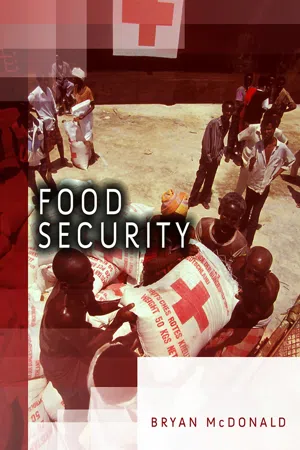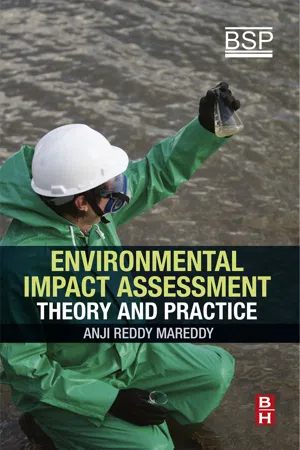Environmental Impact of Agriculture
The environmental impact of agriculture refers to the effects of farming practices on the natural surroundings. These impacts can include soil erosion, water pollution from agricultural runoff, deforestation for farmland, and greenhouse gas emissions from livestock. Sustainable agricultural practices aim to minimize these negative impacts and promote environmental conservation.
5 Key excerpts on "Environmental Impact of Agriculture"
- eBook - ePub
- Bryan L. McDonald(Author)
- 2013(Publication Date)
- Polity(Publisher)
...The chapter considers environmental impacts in five major sectors: land and soil; water use and water quality; habitat and biodiversity loss; energy use; and climate change. The chapter concludes with a discussion of ways to reduce the Environmental Impact of Agriculture and food production. This discussion focuses particular attention on the need to develop food systems that provide for human needs while also aiding efforts to both mitigate and adapt to processes of global environmental change, a process that I argue can be harmonized with efforts to increase agricultural sustainability. Impacts on land and soil Covering only about one-third of the earth’s surface, land is indispensable to agriculture and livestock production. These land resources, according to a definition by UNEP (2002) include soil, land cover, and landscapes. Land and soil provide a range of additional benefits, including regulating hydrological cycles and aiding in the preservation of biodiversity, carbon storage, and other ecosystem services (the resources and process provided by natural systems that are beneficial to human livelihoods and well-being). Though finite, the functional amounts of land and soil resources, along with water and nutrients, are, as Smil (2000) asserts, variable with management practices that considerably affect their quality and efficiency of use. Many current agricultural practices reduce the ability of ecosystems to provide goods and services such as carbon sequestration and soil retention and absorption of water. The amount of land under agricultural cultivation has increased steadily in developing regions while remaining largely constant in developed regions, with the largest gains in cultivable land made in the mid-twentieth century (UNEP 2008). Degradation and pollution of land resources, such as the overuse of fertilizers and other chemicals, has also occurred as a result of policy failures and unsustainable agricultural practices (UNEP 2002)...
- eBook - ePub
Environmental Impact Assessment
Theory and Practice
- Anji Reddy Mareddy(Author)
- 2017(Publication Date)
- Butterworth-Heinemann(Publisher)
...7 Impacts on soils and land environment Abstract In this chapter, a brief description of soil system and classification of soil focusing on different types of soils are clearly discussed. The causes of land degradation, i.e., soil erosion, desertification, salinization, acidification, and landfilling of waste, are presented with special reference on soil erosion types, effects on productivity, and erosion control technologies. In the second part of this chapter, environmental impacts on soil and land, conceptual approach for soil impact identification, description of existing soil environment, and soil quality standards are also presented. Further, the prediction of soil impacts their significance and later specially focused on incorporation of mitigation measures aiming at soil reclamation and remediation, which are presented in this chapter. Keywords Soil erosion; Productivity; Soil reclamation and remediation Land-use change is one of the main drivers of many environmental change processes. It influences the basic resources of land use, including the soil. Its impact on soil often occurs so creepingly that land managers hardly contemplate initiating mitigative and counterbalance measures. Poor land management has degraded vast amounts of land, reduced our ability to produce enough food, and is a major threat to rural livelihoods in many developing countries. Land development, resource extraction, and waste-disposal projects can cause certain undesirable impacts on soil and land resources. These impacts may be in the form of either quantity or quality changes. In addition, activities that may result from development projects, such as urban growth near a new water-supply reservoir, can cause soil, land, and/or groundwater effects as a result of urban-waste-disposal leachates moving through the subsurface system...
- eBook - ePub
Current Developments in Biotechnology and Bioengineering
Crop Modification, Nutrition, and Food Production
- Suresh Kumar Dubey, Ashok Pandey, Rajender Singh Sangwan(Authors)
- 2016(Publication Date)
- Elsevier(Publisher)
...Worldwide agricultural production is governed by the combination of climate, soil tilth, technology, genetic resources, and farm management decisions such as tillage, manure and fertilizer applications, and crop variety selection [ 8, 13, 35 – 40 ]. Uncertainties related to the representation of CO 2, nitrogen, and high-temperature effects demonstrated that further research is urgently needed to better understand effects of climate change on agricultural production and to devise targeted adaptation strategies [41]. The question thus arises, how can productivity be increased while ensuring the sustainability of agriculture and the environment for future generations? Decision makers need information supplied by research to make informed choices about new agricultural technologies and to devise and implement policies to enhance food production and sustainability. There is now great concern about the decline in soil fertility, the change in the water table, rising salinity, resistance to many pesticides, and the degradation of irrigation water quality in some parts of the world [ 42 – 45 ]. It is clear that over time more nutrients have been removed than added through fertilizers, and farmers have to apply more fertilizers to achieve the same yield they were getting with less fertilizer 20–30 years ago. Climate change will further affect soil conditions. Changes in temperature and precipitation patterns and amount will influence soil water content, runoff and erosion, salinization, biodiversity, and organic carbon and nitrogen content. The increase in temperature would also lead to increased evapotranspiration. The specific regional soil-related problems are closely linked to the global environmental change. Therefore, there is a need to quantify the effect of this change on the soil-fertility and function that governs the crop growth and production. Global warming may also threaten food security if there is a negative effect on agriculture...
- eBook - ePub
- Colin G. Scanes, Samia Toukhsati(Authors)
- 2017(Publication Date)
- Academic Press(Publisher)
...Chapter 18 Impact of Agricultural Animals on the Environment Colin G. Scanes University of Wisconsin–Milwaukee, Milwaukee, WI, United States Summary All animals influence the environment to varying extents. The production of livestock and poultry has marked impacts on the environment influencing water, air, and soil. Manure or animal waste is the predominant source of concern particularly with intensive animal agriculture. At the time of writing, in the USA, livestock and poultry produce 120 million metric tons of manure in dry weight. Some researchers put the impact of animal agriculture at 27% of total human water usage globally for the production of livestock (including water used to grow the feed grains). When there are problems in management, livestock and poultry can reduce water quality. There is contamination of water from livestock and poultry facilities including phosphate and nitrate, pathogens (viruses, bacteria, and protozoa), antibiotics, and androgenic agents. Nitrates and phosphate contamination of waterways and estuaries is leading to algal blooms, eutrophication, and hypoxic areas. Antibiotics are used extensively in pig and poultry production while anabolic agents are used for cattle. Agriculture contributes 11% to global greenhouse gas emissions with ruminants adding methane. Among the gases from livestock and poultry that are potential problems are the following: carbon dioxide, ammonia, total reduced sulfur including hydrogen sulfide, and water vapor together with odors. The latter can be offensive to neighbors of farms and have the potential to impact human health. Moreover, viruses can be transmitted from animal facilities to humans via aerosol particles...
- eBook - ePub
Population, Agriculture, and Biodiversity
Problems and Prospects
- J. Perry Gustafson, Peter H. Raven, Paul R. Ehrlich(Authors)
- 2020(Publication Date)
- University of Missouri(Publisher)
...A recent assessment of projected land uses suggested that, by 2040, more than a thousand threatened species may lose a majority of their habitat (Pouzols et al., 2014). A global analysis of conflict zones between biodiversity and food security goals identified several key areas like Madagascar and the Peruvian Andes (Molotoks et al., 2017). These areas and others emphasize the need for interdisciplinary approaches by a diversity of disciplines including agro-ecologists, conservation scientists, and social scientists focused on understanding food demand and cultivation practices to minimize, mitigate, and predict possible adverse effects of agricultural production on biodiversity and the environment. These studies and many others also emphasize the need to understand these risks at a local level. Here, we discuss three case studies exemplifying harmful effects of current and expanding agriculture. We discuss both indirect impacts of agricultural activity, human wildlife conflict, and the direct impact of habitat loss. The first case is a discussion of human wildlife conflict in savanna Africa. The second and third cases, focusing on habitat loss, discuss the Mata Atlântica of Brazil and the expansion of oil palm cultivation across the global tropics, respectively. Crucially, even in areas where agricultural expansion does not result in species extinctions it may affect local populations in a way that alters overall community structure. One classic example of this is the increase in white-tailed deer populations (Odocoileus virginianus) throughout the eastern United States. Deer are habitat generalists and easily adapt to vegetation changes. They benefit from local population declines and extirpations of predators including puma (Puma concolor) and gray wolves (Canis lupus)...




